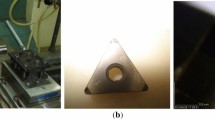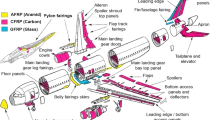Abstract
The qualities of plasma cut-edges generated on S355 structural steel were investigated to understand their effect on durability. These edges are left exposed in often critical areas after final assembly of bridge and load bearing applications, in which the damaging characteristic defects formed during the cutting process can act as initiation sites for fatigue cracks. Cuts were generated using oxygen and air at a range of commercial traverse cutting speeds that are used to fabricate structural components. A comparison of topographical properties and microstructural observations confirmed that the changes in the cut-edge surface and internal properties were significantly altered by the plasma gas type. Through the characterisation of cut-edges, optimum process parameters were determined that minimise the level of cut-edge microstructural and surface damage. An improvement in understanding the mechanisms that form irregularities on plasma cut-edge surfaces has been developed, so that damage inducing characteristic properties can be minimised. This has resulted in establishing the influence of characteristic properties on resulting fatigue life, as a means to generate plasma cut-edges that are near to optimum. This was tested using a representative top-hat beam component, in order to validate these results and act as guidance towards the fabrication of structural steel which have optimum cut-edge durability.
Similar content being viewed by others
References
Aichele, G. (2003). “In competition with laser cutting.” Journal of Mechanical Engineering, 14(64), pp. 130–132.
Chiarelli, M. and Lanciotti, A. (2000). “Effect of plasma cutting on the fatigue resistance of Fe510 D1 steel.” Journal of Engineering Materials and Technology, 122, pp. 141–145.
Dong, P., Cahill, P., Yang, Z., Chen, X. L., and Mattei, N. J. (2004). “Plate residual stress effects on dimensional accuracy in thermal cutting.” Journal of Ship Production, 20(4), pp. 245–255.
Ferrington, L. (1994). “New oxygen plasma process rivals laser-cutting methods.” Welding Journal, 73(6). pp. 65–69.
Gane, N., Rogozinski, M. W., Polivka, F., Doolette, A. G., and Ramakrishnan, S. (1994). “Quality of cut in air plasma arc cutting.” Journal of Physics D: Applied Physics, 30(4), pp. 636–641.
Gariboldi, E. and Previtali, B. (2005). “High tolerance plasma arc cutting of titanium quality investigation and optimization.” Journal of Materials Processing Technology, 160(1), pp. 77–89.
Gurney, T. R. (1979). Fatigue of welded structures. 2nd Ed. Cambridge University Press.
Irving, B. (1992). “High-tolerance plasma arc cutting carves out some niches in industry.” Welding Journal USA, 71(10), pp. 33–37.
Kirkpatrick, I. (1992). Modern developments in plasma cutting. Welding & Metal Fabrication, pp. 321–332.
Kirkpatrick, I. (1998). “High definition plasma an alternative to laser.” Aircraft Engineering and Aerospace Technology, 70(3), pp. 215–217.
Landry, C. (2001). Improving plasma cutting in sheet netal applications. http://archive.metalformingmagazine.com/1997/09/plasma/997plasma.htm. Last Accessed 9th May 2011.
Lucas, B. and Hilton, D. (2003). Cutting processes — plasma arc cutting — process and equipment considerations. http://www.twi.co.uk/professional/protected/band_3/jk51.html. Last Accessed 9th May 2011.
Marronne, E., Labesse-Jied, F., Galtier, A., and Robert, J. L. (2003). “Cutting process influence on fatigue properties of steel sheets.” Advanced in Damage Mechanics, pp. 13–22.
Meurling, F., Melander, A., Linder, J., Larsson, M., and Trogen, H. (1998). The Influence of Laser Cutting on the Fatigue Properties of Thin Sheet Steels. Swedish Institute for Metals Research Report IM-3691.
Meurling, F., Melander, A., Linder, J., and Larsson, M. (2001). “The influence of mechanical and laser cutting on the fatigue strengths of carbon and stainless sheet steels.” Scandinavian Journal of Metallurgy, 30, pp. 309–319.
Nemchinsky, V. A. (1998). “Plasma flow in a nozzle during plasma arc cutting.” Journal of Applied Physics D, 31(21), pp. 3102–3107.
Parke, G. and Hewson, N. (2008). Institute of Civil Engineers Manual of Bridge Engineering, 2 nd Edition. Thomas Telford Ltd.
Prokopenko, A. V. (1991). “Effect of plasma cutting on the fatigue and cracking resistance of steel.” Strength of Materials, 22(12), pp. 1738–1740.
Ramakishnan, S. and Rogozinski, M. W. (1997). “Properties of electric arc plasma for metal cutting.” Journal of Applied Physics D., 30(4), pp. 636–644.
Ramakishnan, S., Geshenzon, M., Polivka, F., Kearney, T. N., and Rogozinski, M. W. (1997). “Plasma generation for the plasma cutting process.” IEEE Transactions on plasma science, 25(5), pp. 937–946.
Severance, W. S. and Anderson, W. (1984). “How plasma arc cutting gases affect productivity.” Welding Journal, 63(2), pp. 35–39.
Zajac, A. and Pfeifer, T. (2006). “Restricting the heataffected zone during the plasma cutting of high-alloy steels.” Welding International, 20(1), pp. 5–9.
Author information
Authors and Affiliations
Corresponding author
Additional information
Note.-Discussion open until May 1, 2012. This manuscript for this paper was submitted for review and possible publication on August 4, 2011; approved on December 16, 2011.
Rights and permissions
About this article
Cite this article
Thomas, D.J. Optimising plasma cut-edge properties for improving the durability of bridge structures. Int J Steel Struct 11, 481–493 (2011). https://doi.org/10.1007/s13296-011-4007-6
Published:
Issue Date:
DOI: https://doi.org/10.1007/s13296-011-4007-6




